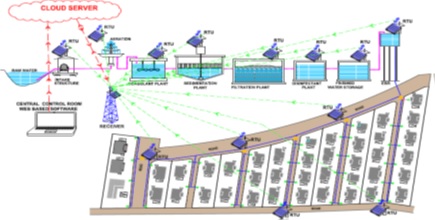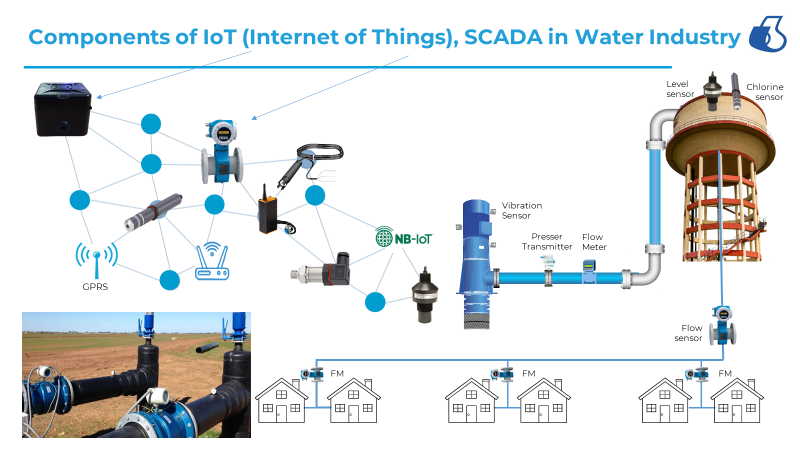By Evelin Madzin, NRW Expertise Center of Budapest Waterworks
The importance of drinking water Access to clean, safe water is one of the world’s most pressing needs, as described by UN’s Sustainable Development Goal (SDG 6) also, billions of people live without access to safe drinking water, sanitation and hygiene. Beside the need for clean drinking water, areas of the globe suffer from water shortage; they have limited access to water sources enough for the growing population. So it is more and more important to ensure that the water already treated, ready for consumption should actually reach consumers. Yet today’s water distribution systems lose a significant part of supply because of leaks. Beside the shortage of sources, the problems related to non-revenue water (NRW) increase the pressure on water utility suppliers already operating under hard circumstances. Briefly about NRW Due to various reasons and factors, water utilities cannot sell some of the water produced, so the amount of non-revenue water causes a significant loss of revenue. The total cost to water utilities caused by NRW worldwide can be conservatively estimated at $ 141 billion per year according to the World Bank. In addition, the real / physical loss part of NRW has supply and safety, economic, ecological and environmental effects as well. According to the International Water Association’s (IWA) methodology, we talk about real loss when a large amount of water disappears within a given time through various forms of damage to the network.
However, in addition to physical losses, another component of the NRW is commercial losses. Significant commercial losses are caused by the inaccuracy of water meters, any form of unauthorized consumption, and data handling, billing errors. In this article, the method of physical loss reduction activity of Budapest Waterworks is presented. About Budapest Waterworks Managing water loss in the water supply system of Budapest Waterworks is an elaborate and determinative task for several departments of the company. The problem of losses deserves e attention and appropriate actions to reduce avoidable stress on our valuable water resources. As a result of the NRW reduction activity receiving special attention as a complex activity, we have been able to keep our NRW levels around the target rate for several years now, while operating a network of considerable average age and of various pipe materials. In terms of size and quality of technology. Budapest Waterworks, with its more-than-150-year-long history, is one of the leading water utility service providers in Central Europe. Over 5,000 kilometres in length, our drinking water pipe network supplies the Hungarian capital and its conurbation area. Water treatment, network management and water quality testing activities are supported by world-class technologies. For today both drinking water production and supply systems are fully automated. Our activities related to wastewater treatment and network, among others, include the operations of the Budapest Central Wastewater Treatment Plant, which has a capacity of 330,000 m3/day and is equipped with state-of-the-art, environmentally-friendly solutions. Using our experience in the core activities, we launched international activities in the mid2000s focusing on water and waste water facility construction projects and consultancy services to utility operators around the world. Physical losses According to the IWA methodology, we talk about real loss when a large amount of water disappears within a given time through various forms of damage – such as leakages, pipe bursts – to the network. This includes losses due to operational faults such as reservoir overflows, other control faults, careless closing and emptying, etc. losses incurring during the given period. The loss of the network worsens the profitability of the operator because 8 some of the water extracted and supplied, and therefore of value, is lost; 8 it causes higher capacity requirements of the water supply network; 8 Leaks – in addition to the value of the run off water – cause consequential damage (basement soaking/flooding, public utility damage, etc.) to property in the vicinity. Physical loss management Based on the IWA’s recommendation, the following four main activities can be used to reduce physical losses to a level that is as close as possible to the unavoidable level of loss: 8 active leakage control activity (ALC); 8 pressure management; 8 speed and quality of repairs; 8 pipeline and asset management. From the above activities, the first one is explained in this article. The purpose of active leak detection is to detect hidden damage of the water network. In the leak detection process the first step is to monitor the network with minimum night-flow measuring vehicle and/or with DMAs. This will determine if there are hidden leakages in that area. If so, the measurement results can be used to estimate their quantity, extent. Thus, the place of the leakage can be determined in advance. The second step is to pre-locate. Thus, the faulty section will be specified. And finally the third and the last step is to pinpoint the location of the fault. District metered areas (DMAs) are defined as an invisible area of a distribution network. They are usually created by closing boundary valves and water meters. Measuring the water flowing into and out of the DMA, we get knowledge of how much the district’s minimum night flow is. Based on minimum night flow data we can conclude the size/extent of leakages. Active Leakage Control Activity at Budapest Waterworks in practice Our active leakage control activity at Budapest Waterworks began in 1986. The number of staff supporting this activity and the tools used has been constantly improving. Our experience in the field of districts metered areas: 8 75 DMAs in 16 zones; 8 177 measurement points; 8 SCADA integration; 8 Several special reports and dashboards. From every measuring point we get data once per day by SMS communication. Data contain quarter-hour flow values, which are processed, reported and analysed via SCADA and Power BI. Let’s see some case studies. Case study 1. The first study is an example for data analysis of a district metered area. Zone 14. in Budapest consists of 3 districts via 2 measuring points: 14/1, 14/2 and 14/3. Diagram 1. shows an example of this method. This Diagram illustrates the input volumes of district no.14/3 in the given period. It can be seen that the value of water input grew very slow in January, 2019. After that a higher jump in values occurred suddenly. Diagram 2. shows the minimum values of daily district input. This values are typical at night period. As a conclusion of the fact that the night input curve has also grown, it can be said that a hidden leakage is the cause of this change. After the data analysis, the ALC team examined the area. During the examination a big hidden leakage was detected in the pipeline. The failure was on a distribution pipe with 7 m3/h extension. The district is located in a hilly, rocky area, so water can flow unnoticed. After the repair works, the values decreased to the same level as the initial values – as can be seen in the chart at the beginning of March. Finally, with the onset of spring, the warmer weather increased the water demand of the area and, accordingly, the input values of the zone also increased. Case study 2. The second study is an example for a small zone, which does not contain DMA district because its water network is only 5.1 km long. This size is perfect to analyse water losses without breaking it down into smaller districts.The input volumes of Zone 6. called Ruthén between October, 2020 and January, 2021. It can be seen that in the middle of October the lowest values started to increase. Further growth was seen in November. During this period the values increased from around 20 to circa 33 m3/h. The change can also be observed in the minimum values at night in Diagram 4. This clearly indicated the presence of a leak or leaks. The ALC team examined the area. During the examination two hidden leakages were detected in the pipeline which were repaired in two steps, on 14, December and on 22, December. This failures caused a total of 18 m3/h drained water. After the repair works the values decreased to 15 m3/h. Case study 3. The example below is a great illustration of what happens when we are not doing ALC activity in a particular area. Diagram 5. shows the daily input values for Zone 10. between 2018 and 2021. The total network length of this zone is 92 km which is not divided into smaller districts. In the case of large amounts of water, it is clear that a few m3 of water exfiltration caused by leaks is difficult to detect. Sometimes it takes several years for a trend to show in the data. Case study 4. Diagram 7. below shows the daily consumption profiles of the different smaller zones, which have the same features (e.g. length of network, number and types of buildings). That is why the daily consumption profiles are similar to each other in normal circumstances. The blue line shows the values of zone no 18., which is different from the others. This difference can be experienced in the night period of the day, because of this hidden leakage presence is concluded similarly to the former case. Conclusion The operation of a DMA system requires strong, safe, and robust IT background and connections. The structure of water distribution is based on a SCADA system and DMA network; therefore, Budapest Waterworks can manage the supervision of about 120 separate zones. Several special reports and dashboards support the control of consumption trends of each area. These reports can help ourALC activity. Active leak detection is not a task but an activity. Accordingly, feedback and continuous monitoring are important. Although clear, it is important to note that the reduction of NRW (whatever kind the loss is) is done through the steps . By creating a monitoring system and data collection; targeted and efficient fault location can be supported in order to focus on the losses that occur. The actual reduction in losses, on the other hand, depends solely on the speed and effectiveness of the repair (repair of pipe damage, replacement of meters, elimination of illegal connection, etc.). The analysis is based on strong and reliable data collection, however, loss reduction can only be done through actual physical or customer service administration work. Exploration of the reserves inherent in the operation, reduction of losses is of paramount importance in the current operation of the sector. Our strategies have driven to optimum efficiency achieved, decreased source extraction, optimised system operation and energy usage. After 35 years of hard work on the topic, Budapest Waterworks collected a wide range of experience concerning the reduction of water losses enabling us to finetune and revise original starting assumptions and expectations thus ensuring that the strategy we have developed will bring results. As an operator active in international markets using our experience in the core activities, Budapest Waterworks can support other utilities in their work in the field of NRW reduction as well.





